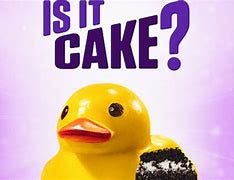One of my guilty pleasure shows is the Netflix reality competition Is It Cake?. Season 2 recently dropped, and as a game designer (and viewer) there were a few aspects of the competition this season that really raised my eyebrows and my ire, and I think are instructional for all designers out there.
For those unfamiliar, Is It Cake? challenges incredibly talented bakers to create cakes that are indistinguishable from real objects. You can see some of their amazing work in this video:
The way that the competition works is that 4-6 bakers are working on their cakes, and are also given ‘decoys’, which are real objects of the same type.
The judges are then presented with a line up of four objects - three real and one cake. And they have to pick out the cake.
You can see this right at the start of the video above, with the bowling balls.
If the judges find your cake you are up for elimination. If they don’t you move on to the next round.
Towards the end of the first season there was a bit of controversy when one of the bakers messed with his decoys. He was making tacos, and added gelatin pieces of tomato to the decoys, specifically to make the judges think the decoys were cake.
The show runners decided that modifying the decoys was allowed within the rules.
In season 2 this decoy modification became rampant. If the bakers couldn’t quite get the color of their cake right, they airbrushed the decoys with the cake coloring. If the bristles on a brush didn’t look realistic, they took a miniature blowtorch to the actual brush bristles to make them look off.
To me, this creates a mismatch between the ostensible reason for the game’s existence, and the way it is expressed in the rules. Rather than elevate the cakes to more closely resemble actual objects, players are making actual objects look more like cake.
The promise of the game is:
We are trying to find the person who is the best at making these incredibly lifelike cakes.
The rules do not fulfill that promise. The rules turn the game into:
We are trying to find the person who makes it the most difficult for the judges to tell which is an actual cake.
Sometimes these overlap. Often they overlap. But they don’t have to. This leaves a lot of room for gamesmanship of which modifying the decoys is one avenue.
However, it also led to a deeper problem with one episode. One of the bakers did not manage her time properly, and had a basically unfinished cake. The shape represented the object, but it had no color (it was just white, unlike the decoys, which were a combination of colors). There were no details. It clearly did not look at all like what it was supposed to.
And yet, when the judges saw it alongside the actual objects, they did not think the cake could possibly be cake. These were supposed to be the best bakers in the United States for this type of decorating. It was clear that a decoy had been set up by the baker to specifically look like cake. They would not fall for this obvious trap, and so guessed that one of the decoys was actually the cake.
They were wrong of course, so she moved onto the next round. And a player that had a much, much better cake from a technical standpoint was eliminated.
During the closing credits you could actually hear one of the judges walk up to the ‘white cake lump’ baker and ask if she deliberately did that to mislead them. She did not - it was clear from watching the baking that she intended to make a great cake, but at the end felt that because of how far behind she was, this Hail Mary was the only option.
And it worked. It leveraged the judges’ assumptions that these were good bakers trying to win with the best cake.
This is not related to modifying the decoys. In fact, in this case the baker deliberately didn’t touch the decoys to emphasize how bad her cake was. But the fact that decoys could be modified left that doubt in the judges’ minds that this might be a ‘caked up’ decoy.
The rules undercut the entire vision of the game.
I don’t blame the players in this case. As we say in our household You play the game you’re given, not the game you want. (we have a fun household) The players were just maximizing their chances to win. No shame in that.
This is an incredibly important lesson for all designers. Your game - through the theme, back-of-box copy, artwork, everything - is making a promise to the players. Make sure that the actual game matches that promise. Don’t undercut your own vision.





I've had a similar experience watching The Traitors recently. Have you seen this one? 20-odd strangers come to a mansion, most of whom are "Faithful" but several of whom are secretly chosen as "Traitors." During the days, everyone participates in a variety of mostly cooperative games and contests to increase the prize pot. And at the end of each day, everyone votes to banish one person, which is the only way the Faithful can remove a Traitor. And each night, the Traitors "murder" one Faithful. At the end, if all the Traitors have been eliminated, the remaining Faithful split the prize money. But if any Traitor(s) remain, THEY get all the prize money. My problem with this is that the only real way for the Faithful to try and suss out who is a Traitor is their behavior during the day. But BOTH SIDES are equally incentivized to increase the prize pot, so they all behave the same during the contests. I've always thought the incentives should be opposite, so that there are two prize pots, and the Faithful are earning money OUT OF the Traitors prize pot. That would incentivize the Faithful to do well in the contests, and incentivize the Traitors to sabotage the contests while doing all they can to APPEAR to do well. As it stands, I don't see how the Faithful will ever win this game, and in the two seasons I've watched, they never have.
Geoff, your article bakes so many layers of philosophy into this one anecdote.
I can see how you had a reaction of ire. Maybe not just because the players "cheated" but that the producers allowed it. The gameplay no longer matched the titular objective. But gamesmanship can have so much depth to it. (It's kind of another way to say "play," right?) I always* cheer on players who push the boundaries of what's allowed within a ruleset. Or who use unexpected means to wiggle around unwrittens and to explore possibilities in between unwritten lines.
It makes me think of Ender Wiggin in Orson Scott Card's famous novel who tried out that first video game the older kids were playing. His method to beat one of them changed the way they played from that point on. (Actually, pretty much everything that happened in the Ender's Game battle room exemplified gamesmanship!)
*At least when that player is me.